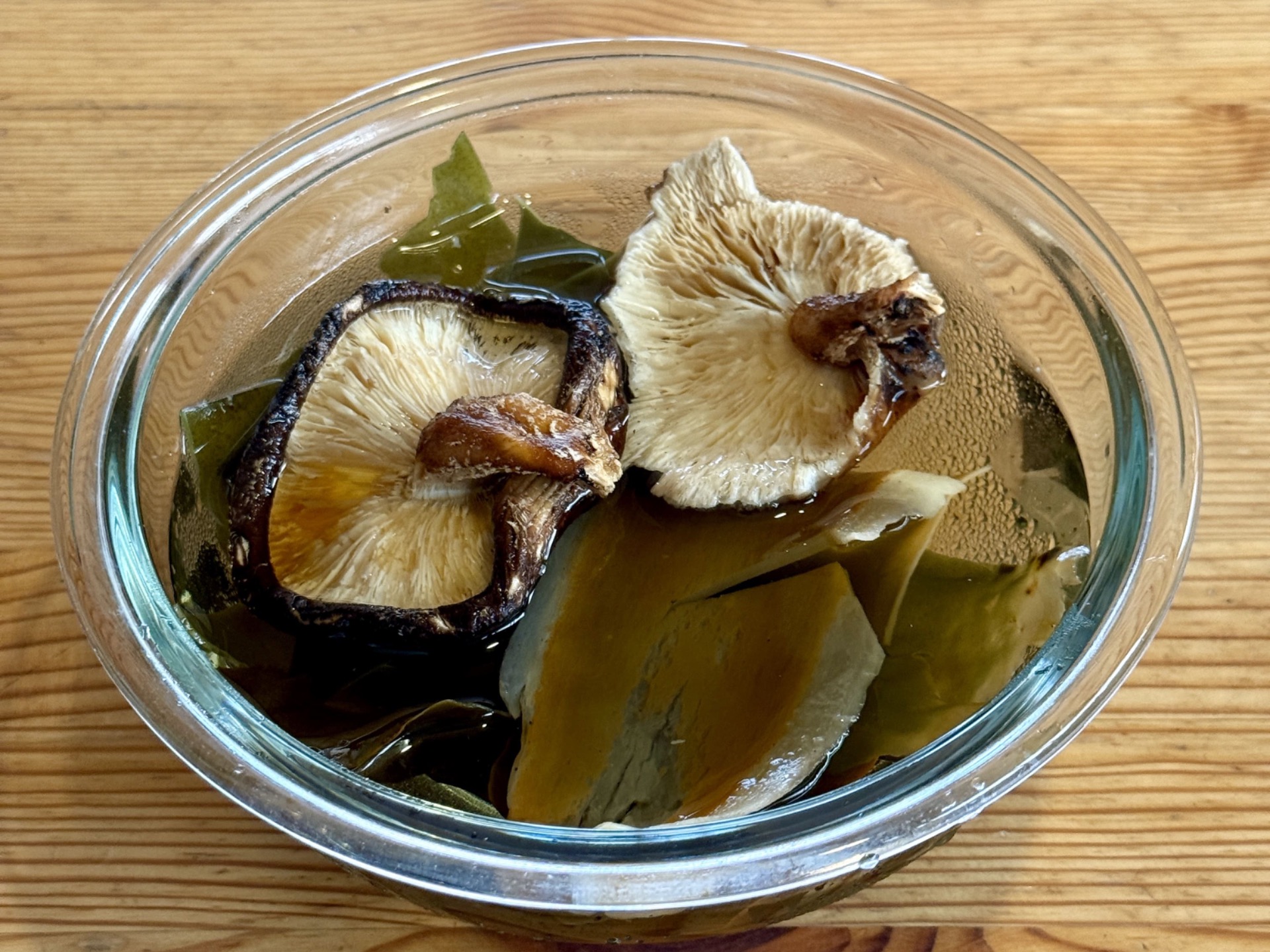🥣 How to Avoid Fish Stock (Dashi) in Japan — Vegan Survival Guide

For Vegans, Vegetarians & Plant-Based Travelers
Traveling in Japan as a vegan or vegetarian can be exciting, but it also comes with a unique challenge:
fish stock (dashi) is used everywhere.
Even dishes that look plant-based often contain fish-based broth.
If you want to enjoy Japanese food safely, understanding how to identify and avoid dashi is essential.
This guide will teach you everything you need to know about avoiding fish stock in Japan—and how to eat safely, especially in Kyoto.
🌱 1. What Is Dashi and Why Is It Everywhere?
Dashi is Japan's fundamental cooking base.
Traditional dashi is usually made from:
・Katsuobushi (dried bonito flakes → fish)
・Niboshi (dried sardines)
・Kombu (seaweed)
・Shiitake mushrooms
While kombu/shiitake versions exist, most restaurants use fish-based dashi, even in dishes that appear vegan.
Dashi
・Miso soup
・Ramen broth
・Udon and soba soup
・Simmered vegetables
・Curry roux
・Tempura dipping sauce
・Rice seasonings
・Pickles
If you don't ask, it almost always contains fish.
⚠️ 2. Foods That Look Vegan but Usually Contain Dashi
Travelers often think these foods are safe—but they usually aren't:
❌ Miso soup
→ Almost always made with fish-based stock.
❌ Tempura dipping sauce (tentsuyu)
→ Always contains bonito-based dashi.
❌ Udon/soba broth
→ Fish-based 100%.
❌ Pickles
→ Often seasoned with dashi or fish-based seasonings.
❌ Japanese curry
→ Many curry roux blocks contain beef or pork extract.
❌ Simmered vegetables
→ Frequently cooked in bonito broth.
❌ Onigiri
→ Some fillings include fish, bonito flakes, or mayo.
👉 Rule: If it's Japanese and liquid-based, assume dashi is included unless proven otherwise.
🥢 3. How to Ask About Dashi in Japanese (Life-Saving Phrases)
Screenshot these phrases and show them when dining out.
✔ "Is this vegan?"
これはヴィーガンですか?
Kore wa vegan desu ka?
✔ "Does this contain fish stock?"
だし(魚)は入っていますか?
Dashi (sakana) wa haitteimasu ka?
✔ "No fish, no meat, no eggs, please."
魚、肉、卵は入れないでください。
Sakana, niku, tamago wa irenaide kudasai.
✔ "Can you make it without dashi?"
だし無しで作れますか?
Dashi nashi de tsukuremasu ka?
Most restaurants will be honest, but many cannot remove dashi because their broth is pre-made.
🌟 4. Safe Vegan Alternatives in Japan
Luckily, Japan has many ingredients that are naturally vegan:
✔ Tofu
✔ Fresh vegetables
✔ Seaweed
✔ Rice dishes (plain onigiri, but check fillings)
✔ Edamame
✔ Soy-based seasonings
✔ Pickles without dashi
But the safest option is to choose fully vegan restaurants or experiences.
🍜 5. Vegan-Friendly Foods You Can Enjoy Safely in Kyoto
Kyoto is the best city in Japan for plant-based travelers.
Here are dishes that are commonly served vegan:
・Vegan ramen (kombu & shiitake broth)
・Vegan gyoza
・Shojin-ryori (Buddhist vegan cuisine)
・Vegetable tempura (with salt instead of tentsuyu)
・Vegan Japanese curry
・Rice bowls with tofu and vegetables
But always check the broth or sauce.
🟩 6. Where to Eat Dashi-Free in Kyoto
Kyoto has more vegan restaurants than most Japanese cities.
Search for:
・Vegan ramen Kyoto
・Vegan cafes Kyoto
・Shojin-ryori temples
Areas with the best options:
✔ Arashiyama
Tourist-friendly and has several vegan-safe cafés.
Also perfect before or after a vegan cooking class.
✔ Gion / Higashiyama
Buddhist cuisine and tofu restaurants.
✔ Kyoto Station & Downtown
Modern vegan cafés increasing every year.
🍳 7. Safest Option: Join a Vegan, Dashi-Free Cooking Class
If you want a completely stress-free experience, a vegan cooking class is the safest way to enjoy Japanese cuisine.
In our class in Arashiyama, we teach:
・How to make two types of vegan ramen without fish stock
・How to prepare plant-based gyoza
・How to select safe Japanese ingredients
・How to cook Japanese food at home
・How to avoid dashi completely
Guests say they feel "safe, informed, and confident" after learning directly from hosts who understand vegan needs.
This gives you lifelong skills to navigate Japan safely.
👉 Learn more: Vegan Ramen & Gyoza Cooking Class in Kyoto
🧭 8. Survival Tips: How to Completely Avoid Dashi in Japan
✔ Tip 1: Assume miso soup is unsafe
Unless you confirm dashi-free.
✔ Tip 2: Choose vegan restaurants or cooking classes
Most mainstream restaurants use fish stock.
✔ Tip 3: Ask about broth every time
Especially ramen, udon, and curry.
✔ Tip 4: Learn simple Japanese phrases
They help more than Google Translate.
✔ Tip 5: Avoid dipping sauces
Tempura sauce and noodle broth are nearly always fish-based.
✔ Tip 6: Look for "plant-based" instead of "vegetarian"
Japan uses "vegetarian" loosely.
✔ Tip 7: Use apps (HappyCow, Google Maps)
Search "vegan Kyoto" or "plant-based Kyoto."
🎉 Conclusion
Avoiding fish stock in Japan may seem difficult, but with some knowledge and preparation,
you can enjoy delicious, safe, plant-based meals throughout your trip—especially in Kyoto.
If you want a guaranteed dashi-free, fully vegan experience with clear ingredient explanations, join our cooking class in Arashiyama.
👉 Book Your Vegan Ramen & Gyoza Cooking Class in Kyoto
A warm, safe, and authentic Japanese home experience.
Enjoyed reading? Join our Vegan Ramen & Gyoza Class in Kyoto!
Book a Cooking Class
